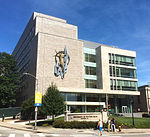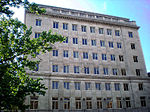University of Pittsburgh Graduate School of Public Health
The School of Public Health (sometimes shortened to Pitt Public Health) is one of 17 schools at the University of Pittsburgh. The school, founded in 1948, was first led by Thomas Parran, surgeon general of the U.S. Public Health Service. It is ranked as the 13th best public health school in the United States by U.S. News & World Report. In addition, it is ranked third among public health schools for funding received from the National Institutes of Health. It was the first of only two fully accredited schools of public health in Pennsylvania (the other being Drexel University's School of Public Health in Philadelphia). The school offers a Bachelor's of Science in Public Health (BSPH), Masters of Public Health (MPH), Master of Science (MS), Master of Health Administration, and doctoral degrees (PhD, DrPH) in areas such as behavioral and community health sciences, biostatistics, environmental and occupational health, epidemiology, health policy and management, human genetics, and infectious disease and microbiology.
Excerpt from the Wikipedia article University of Pittsburgh Graduate School of Public Health (License: CC BY-SA 3.0, Authors).University of Pittsburgh Graduate School of Public Health
Fifth Avenue, Pittsburgh
Geographical coordinates (GPS) Address Website Nearby Places Show on map
Geographical coordinates (GPS)
| Latitude | Longitude |
|---|---|
| N 40.442646 ° | E -79.958211 ° |
Address
University of Pittsburgh (Pitt)
Fifth Avenue 4200
15260 Pittsburgh
Pennsylvania, United States
Open on Google Maps









